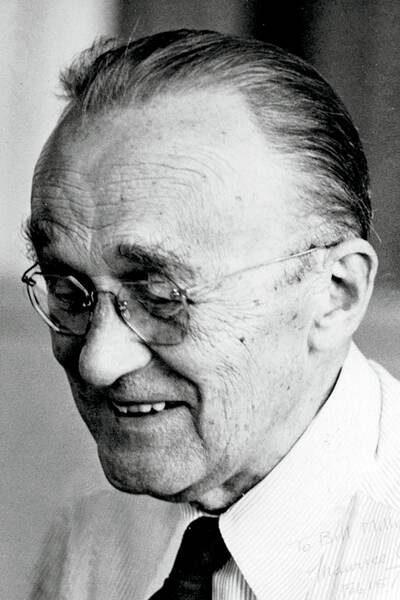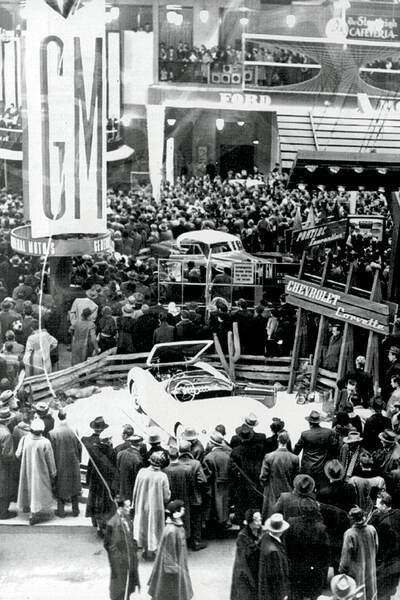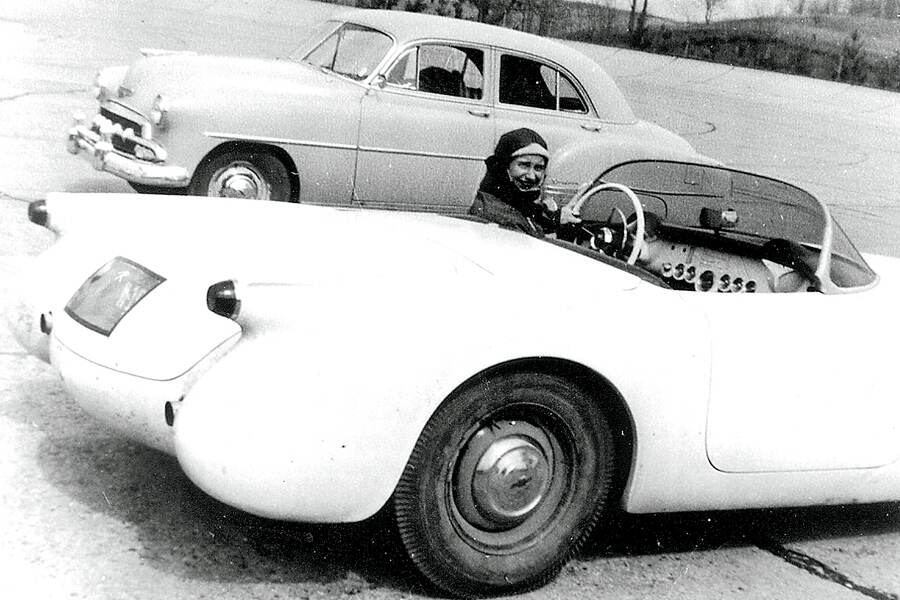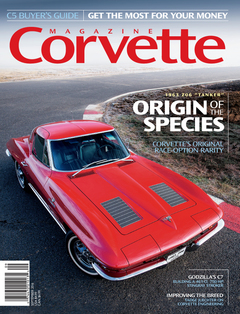That Chevy’s engineers were able to fit all the necessary machinery inside the upcoming C1 Corvette’s tightly wrapped outer skin was a tribute to both chassis engineer Maurice Olley and Styling Staff member Robert McLean, who created the C1 package. Code-named “Project Opel,” the sports car was being built in 1952 for the 1953 Motorama under Shop Order, or SO, 1737.
As specified by Olley, chief of Chevy’s R&D department, the new car’s frame design was not an adaptation of the existing passenger-car frame as many still believe. Entirely special, it had boxed side members and a central X-member to assure high rigidity. Often frame stiffness is sacrificed by piercing the center of such an X-member to allow the driveshaft to pass through, but the drive line of the “Opel” was high enough for the shaft to travel above the central crossmembers. Small apertures in the X-member allowed exhaust pipes to travel through. The complete frame weighed just 213 pounds.
While stock Chevrolets had torque-tube rear axles, Olley realized that the Corvette-to-be would have to give that up for a conventional Hotchkiss drive. A torque tube surrounding the propeller shaft was an effective means of controlling an axle’s torque reactions, but a too-short tube, as required by SO 1737’s 102-inch wheelbase, would be mechanically awkward. Instead, Olley relied on the rear leaf springs to locate the axle. That axle was adapted from the standard Chevrolet component and carried by four-leaf springs that were 51 inches long and two inches wide.
For his front suspension Olley turned to that of the production Chevrolet, which had been completely redesigned by Kai Hansen for the 1949 model. It was of a parallel-wishbone layout, with its wishbone centerlines trailing toward the rear. The suspension was used complete with its circular-section crossmember, which was bolted to the front frame horns to complete the structure. Detail design of SO 1737’s suspension and steering was carried out by R&D engineer Walter “Walt” Zetye, who was beginning a near-lifetime commitment to the Corvette.

One-inch Delco tubular shock absorbers were mounted inside the coil springs, which were standard parts shortened to suit the sports car’s lighter front-end weight. A front anti-roll bar was retained, but located higher on the front crossmember than it was on the sedans. Wheel rates of the suspension were 110 pounds per inch in the front and 115 in the rear, about the same as a Ford or Mercury of that era. This met Olley’s goal of a “smooth yet firm suspension” that provided for wheel deflections of 7.0 inches in front and 5.0 inches in the rear. “Rebound straps are fitted,” said the engineer, “to prevent excessive joint angles in the propeller shaft, which is only 36 inches long.”
The rear leaf springs sloped upward toward the tail, where they were held by tension shackles, to give about 15 percent understeer effect when the car rolled. “This may appear excessive,” Olley observed, “but some of the handling qualities of a car depend on the amount it is allowed to roll on turns. When a car is designed to roll very much less than normal and with a low center of gravity, so that the overturning couple on the tires is reduced, it may become necessary to put a strong understeering tendency into the rear-axle control to provide an adequate tail for the arrow.” After testing it would prove to be beneficial to reduce the amount of understeer effect given by the rear-spring slopes, but Olley was only being prudent in specifying a powerful effect as a first approximation.
“Aiming the arrow” was achieved by an adaptation of the standard Chevrolet steering. GM’s Saginaw Division made a revised worm-and-sector steering box with its ratio sped up from the standard 19.4:1 to 16.0:1. The steering linkage had a two-part track rod divided at the center, where it was actuated by a trailing idler arm. This had a leftward extension that was pushed back and forth by a drag link from the Pitman arm at the steering gear. As established by McLean, the 3-inch-lower engine position required a new design for the idler arm, which pivoted from a double-row ball bearing. Turns lock-to-lock of the 17.25-inch steering wheel—an inch smaller than standard—were not excessive at 3.7. The wheel sloped at only 13 degrees from the vertical.
Studies showed that the car’s weight distribution would be 53/47 percent (front/rear) in running trim with two passengers, approaching 50/50 with a reasonable load in the trunk and a full 18-gallon gas tank. Recognizing this and the car’s lower-than-standard center of gravity height of 18 inches, the braking proportion was changed from the normal Chevrolet 44 percent at the rear to 47 percent. For faster braking response the master-cylinder bore was increased in diameter from .875 to 1 inch. Otherwise the brakes were standard production Chevrolet, with 11-inch composite drums of iron and steel, 2.0 inches wide in front and 1.75 inches in the rear.

Built in prototype form by a team under Rose, the chassis did not differ greatly from those of other mainstream sports cars of the day. Live rear axles and parallel-wishbone front suspensions with drum brakes underpinned such models as the Jaguar XK120, Austin-Healey, Triumph TR2, MG TD and indeed all the early post-war Maserati, OSCA and Ferrari sports cars. France’s Talbot-Lago relied on such a layout, as did Germany’s BMW. America’s Cunningham used de Dion rear suspension for its 1951 models but changed to live rear axles for its 1952 racers and all of its road cars. If anyone was out of step in the early 1950s, it wasn’t Olley.
Summing up his description of the Corvette’s chassis to members of the Society of Automotive Engineers, Olley said he hoped he had not left “the impression that the General Motors Corporation has lost all sense of decorum and is entering the racing-car field. The sports car is a serious form of transportation. It ranks with the chariot, with the tilbury and curricle of the 1800s, with the roadster of the 1920s, as a necessary step in providing convenient, lively transportation for two people in a smaller package. Also it is a bit of an adventure, fun to drive, fun to build.” Olley’s genial and informed imprimatur set the seal on the Corvette’s design.
When it was revealed at the Motorama’s opening at New York’s Waldorf-Astoria Hotel, the official name of SO 1737/Project Opel was revealed as well. Chevrolet advertising agency Campbell-Ewald led a search for a name that ultimately offered some 300 candidates. When none of them quite resonated with Chevy Chief Engineer Ed Cole, news of the search reached Myron “Scotty” Scott, a photographer in Chevrolet’s Public Relations Department.
“I had read about this fast pursuit ship in the Navy called the corvette,” Scott told journalist Amy Lynn Smith. “A couple of days later I sat down and wrote a note to Ed Cole. In essence this is what it said: ‘How would you like to take a ride in my Corvette? As you know the Corvette is the new sports car built by Chevrolet.’ I took it down to his secretary.

“A half-hour later,” Scott continued, “Cole called me up and said, ‘Scottie, how would you like to take a ride in my new sports car?’ I said, ‘New car?’ and he said, ‘Yeah, a new car called the Corvette.’”
“It is named,” said Chevrolet, “after the trim, fleet naval vessel that performed heroic escort and patrol duties in World War II.” On that first car at the Waldorf, “Corvette” appeared in subtle script across the nose, just above the grille and over the enclosed rear license plate. It was also incorporated, with “Chevrolet,” in neat circular medallions above the grille and on the hub of the steering wheel.
When the first Motorama car was shown to GM management on January 12, just four days before the show’s opening in New York, its medallions showed crossed flags: American on the left and checkered on the right. The GM brass “told the styling team that the [American] flag emblem had to go,” wrote Noland Ryan. “It seems that it just wasn’t proper to have the country’s flag in an automobile emblem.” In no time the stars and stripes were replaced by a red flag bearing a fleur-de-lis and the Chevrolet “bow tie” within a shield.
The Corvette received a rapturous reception at the Motorama. “Forming a sea of wide-brimmed hats,” wrote Jerry Burton, “the press elbowed for position. To demonstrate the car’s intended audience GM installed an attractive young couple inside the car that adopted various lovers’ lane poses only to break them off abruptly in mock discovery. As the Corvette rotated on its turntable, hydraulic hoses were connected underneath which raised the hood and trunk automatically to open and close as the car turned. The open hood exposed a beautiful engine with the cylinder-head cover made out of gleaming chrome.” NBC’s Dave Garroway, a great sports-car enthusiast, covered the promising newcomer on his Today show.

GM’s market researchers quizzed show goers to get their reactions to the dream cars on display. They reported that “the Corvette was the outstanding experimental car at the show from the standpoint of buying interest. The general reaction to the overall style and appearance of the Corvette was almost entirely favorable, with over 90 percent of respondents making favorable comment. Over 20 percent used superlatives in giving their opinion about it.” Although the die had already been cast, the Division already having decided to produce the Corvette, this was just the support that Chevrolet needed to get the GM board’s approval.
The next five months were a whirlwind of activity as Chevy Engineering, its factories and the glass-fiber supplier in Ashtabula readied the Corvette for production. Project Opel drivetrain chief Mauri Rose tested the bare chassis, but he was desperate to have a body as well to shake down the new sports car. “He said he had made a reservation on the high-speed oval at the Proving Ground at Milford.” This was the recollection of Steve Koss at GM Engineering’s manufacturing site, Parts Fab, where the first production-design body for the Corvette was ready on June 1, 1953.
“Mauri Rose had been over to Parts Fab,” Koss related, “checking progress of the prototype bodies. Being a three-time winner of the Indy 500, he had the job of building up the mechanical parts for the first Corvettes. As soon as we furnished him with a body, he mounted it on his first chassis, which was waiting at Chevrolet Engineering.”
Maurice Olley also shook down the first version of the chassis he had specified. His daughter had a go in the prototype as well. On one occasion Olley had a visitor, engineer and part-time racing driver Bill Milliken. During a session at the proving ground, Olley said, “I have a new ‘mule’ car we are developing and would like you to tell me what you think about it.”

“I was driving around a handling loop and nearly lost it on a couple of occasions,” Milliken recalled. “Olley reached over and tapped me on the shoulder and said, ‘I just want to mention that this is a prototype car, and it is the only one of these that we have.’ I didn’t realize at the time that it was the first Corvette.” Soon Olley and Rose would have three mules in total, from the five that had been approved, to be put through their paces by R&D engineer William Wolfram during the two months before production was scheduled to begin.
An important opinion would be that of assistant chief engineer Harry Barr, who drove mule serial 856 during the first week of July and then the first production car on July 6. Never intended to be saleable, these first two cars off the Flint line were used for further testing, including durability, then scrapped. “[Car code] C6 has considerable mileage and a Belgian Block test behind it,” Barr advised Ed Cole, “and was in a very noisy condition with excessive rattles in the doors and rear deck.
“Blow-by fumes from the engine were objectionable after a fast run,” said Barr, and “oil smoke is excessive at idle and kick off. With a tail wind the passengers suffer. Carburetor noise level is very tiresome,” Barr continued. “It is all right for a short acceleration demonstration but not enjoyable when going somewhere. Carburetors have a high-pitched whistle off idle and when cracking throttle on run down.” As well, he found, “accelerator pedal is too fast-opening, I could not start on my fine gravel drive without spinning the wheels. Idle stability and general carburetion feel is excellent except as noted.
“Handling and steering are good on cornering and parking” Barr related. “However at speed on a straight road the feel is too sensitive. After driving [a] Porsche, the ride appears too hard,” the engineer averred. He also found that “the seats in this car bottom too easily. This was not as apparent on production No. 1 but in this case the steering wheel to seat clearance is too tight for my build.” An annoyance was that “rain or wash water which had been trapped in the cowl ventilator discharged as a fine mist on the occupants when the [cowl] door was opened at 50 mph.

“The choke control should be on the left side of the steering column for ease of starting,” Barr noted. “It is a difficult two-handed operation now if the proper choke pull-out had not been obtained prior to cranking.” He further informed his boss that the number one production car was getting a 1,000-mile break-in and detailed assessment, following which it was to be delivered to Ed Cole on Friday, July 10 for a weekend drive.
William Wolfram responded to Maurice Olley on the comments raised by Barr.
“The only positive cure for carburetor noise,” he said, “was found to be a duct connecting all three carburetor openings together and taking the induction air from ahead of the radiator. The duct provided other positive gains. Chassis dynamometer tests showed a gain of some 10 to 26 hp with the duct. Road acceleration tests [from] 60-90 mph showed approximately one second gain in fourteen seconds or 7-percent gain in acceleration. Road acceleration 0-60 mph showed similar gains. Provisions are in the body for installation of a duct.” Here were useful findings that would only be exploited in the Corvette’s fuel-injection era.
Both Barr and Olley remarked on “excessive shake” on roads that were rough or lumpy, although, in the experienced Olley’s view, it was “no worse than one would expect on a car of this type.” He suggested that “the Corvette is certainly the first candidate for ‘bottles,’ which might have a profound effect on ride and handling.”
By “bottles” Olley meant dynamic mass dampers, devices attached to bumpers or at a car’s frame periphery that contain spring-controlled masses moving vertically. Properly tuned, such dampers are effective in suppressing a vehicle’s unwanted motions. Packard and Rolls-Royce both used them in bumper-mounted form in the 1930s, and they were an integral part of the Citroën 2CV’s suspension. With industry supplier Bendix experimenting with them in the 1950s, it could have been a source for such “bottles.” The idea was not pursued, however.
When Cole got his hands on Corvette number one, body engineer Carl Jakust told the SAE, he took it “on a trip to determine how good a job the engineers had done. Unfortunately it rained and the side door seals, which were located between the top edges of the doors and the cowl and which were intended to conduct the water forward to run down the front edges of the door, leaked at the rear ends and conducted all the water that ran off the windshield into the interior of the body. This process was assisted by air pressure, which could not have been improved on as a means of accelerating the entrance of the water.
“He soon found out that reinforced plastic made a pretty good boat,” Jakust continued about Cole’s test, “because the water started to collect in the floor and before long there was quite a pool. The additional moisture inside the body caused the windows to steam up and when he reached into the door storage compartment to get a rag to wipe the windshield he found the water level in the door even higher than that in the floor. In fact, there were four inches of water in the door and, to top it off, his camera was in it.
“I won’t go into the details of the instructions we received to correct this deficiency,” Jakust added, “but can assure you that the action was prompt. We improved the seal between the door and the pillar and—just in case there was still a leak—added holes in the bottom of the side doors and in the floor of the cockpit.” When the chief engineer is your tester—especially if he’s “Fast Eddie” Cole—you don’t want to drag your feet.





